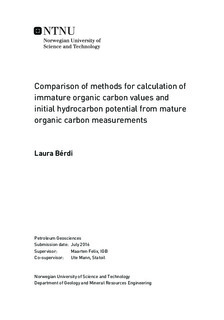| dc.description.abstract | In this study, five mass-balance-based (Peters et al., 1996; Jarvie et al., 2007; Jarvie, 2012) and curve-fitting methods (Banerjee et al., 1998; Dahl et al., 2004) are analysed that have been developed to determine the immature geochemical properties of mature organic matter on the basis of measured values. Based on the published workflowof these methods, a MATLAB code was constructed for each method. Four data sets were selected from various locations representing immature to overmature organic matter of kerogen types I−IV, to observe how their results compare and to determine the limitations of the methods. On the basis of the calculated initial values, interpretations of the organic-richness, of the quality of the immature organic matter and of the organic facies and depositional environment were made, to test whether these would change depending on the method used for back calculation.
The mass-balance-based and line-fitting methods calculated comparable original organic carbon values, suggesting the same organic-richness for each data set. The initial hydrocarbon generative potential and original hydrogen index values show large variations and the interpretation of these parameters is dependent on the applied method. The Jarvie et al. (2007) method yielded the highest initial hydrocarbon generative potential values for most of the data sets, while there is no method which computed consistently lower values than the others. The matrix corrected original hydrogen index values calculated by the Dahl et al. (2004) method were larger than the uncorrected values of the same method and the results of the other methods for the majority of the data sets. The uncorrected initial hydrogen index values of the Dahl et al. (2004) method were similar to the results of the other methods in general. Furthermore, due to the variation in the calculated original hydrogen index values of the different methods, the results suggested different depositional environment interpretations in most cases depending on the method used for back calculation. The transformation ratio values computed by the methods indicated the same maturity stage for the organic matter in most of the data sets.
Furthermore, it was observed that the mass balance based methods do not provide realistic results in the absence of proper data about the quality and origin of the immature organic matter. Moreover, this study confirms the conclusions of Dahl et al. (2004), that their method cannot account for frequent changes in the depositional environment. | en |

